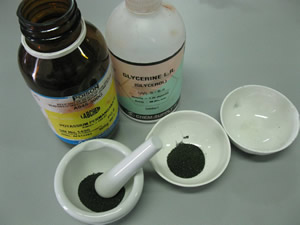Surface area and rate
demonstration
This activity vividly demonstrates the relationship between surface area and rate of reaction .

Safety
Potassium manganate is a strong oxidant.
Apparatus :
- Potassium manganate (KMnO4)
- Glycerol
- mortar and pestle
- 2 evaporating dishes
- 2 X 10 mL measuring cylinders
Step 1 Place a 1.00 gram sample of potassium manganate in an evaporating dish, as shown above.

Step 2 Finely crush a 1.00 gram sample of potassium manganate using a mortar and pestle. Place it into an evaporating dish, as shown above.
Place both evaporating dishes in a fume cupboard

Step 3 Measure 2 mL of glycerol in each measuring cylinder and simultaneously pour into the evaporating dish on top of the potassium manganate.
Close the hood of the fume cupboard and wait.
Before ignition white smoke should appear coming from the mixture of glycerol and potassium manganate.
View the video on the right. You will see two crucibles in a fume cupboard. On the right is finely ground potassium manganate. On the left is the potassium manganate with large crystals.
3) From the list below, which are factors that will increase the rate of a chemical reaction? Explain why in terms of collisions.